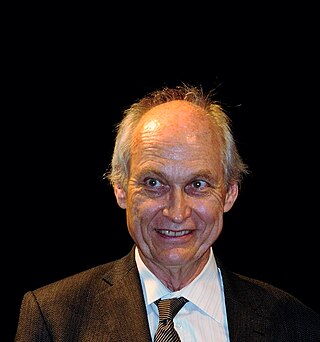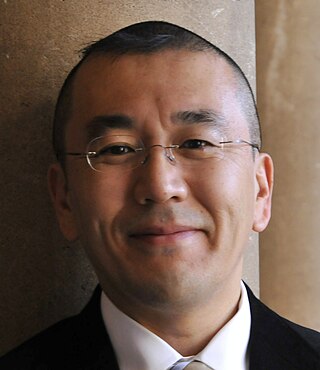Related Research Articles

David Norman Schramm was an American astrophysicist and educator, and one of the world's foremost experts on the Big Bang theory. Schramm was a pioneer in establishing particle astrophysics as a vibrant research field. He was particularly well known for the study of Big Bang nucleosynthesis and its use as a probe of dark matter and of neutrinos. He also made important contributions to the study of cosmic rays, supernova explosions, heavy-element nucleosynthesis, and nuclear astrophysics generally.
The Kavli Institute for Theoretical Physics (KITP) is a research institute of the University of California, Santa Barbara. KITP is one of the most renowned institutes for theoretical physics in the world, and brings theorists in physics and related fields together to work on topics at the forefront of theoretical science. The National Science Foundation has been the principal supporter of the institute since it was founded as the Institute for Theoretical Physics in 1979. In a 2007 article in the Proceedings of the National Academy of Sciences, KITP was given the highest impact index in a comparison of nonbiomedical research organizations across the U.S.

Michael S. Turner is an American theoretical cosmologist who coined the term dark energy in 1998. He is the Rauner Distinguished Service Professor Emeritus of Physics at the University of Chicago, having previously served as the Bruce V. & Diana M. Rauner Distinguished Service Professor, and as the assistant director for Mathematical and Physical Sciences for the US National Science Foundation.

Eugene Newman Parker was an American solar and plasma physicist. In the 1950s he proposed the existence of the solar wind and that the magnetic field in the outer Solar System would be in the shape of a Parker spiral, predictions that were later confirmed by spacecraft measurements. In 1987, Parker proposed the existence of nanoflares, a leading candidate to explain the coronal heating problem.

Saul Arno Teukolsky is a theoretical astrophysicist and a professor of Physics and Astronomy at Caltech and Cornell University. His major research interests include general relativity, relativistic astrophysics, and computational astrophysics.
The Dannie Heineman Prize for Astrophysics is jointly awarded each year by the American Astronomical Society and American Institute of Physics for outstanding work in astrophysics. It is funded by the Heineman Foundation in honour of Dannie Heineman.

Peter Goldreich is an American astrophysicist whose research focuses on celestial mechanics, planetary rings, helioseismology and neutron stars. He is the Lee DuBridge Professor of Astrophysics and Planetary Physics at California Institute of Technology. Since 2005 he has also been a professor at the Institute for Advanced Study in Princeton, New Jersey. Asteroid 3805 Goldreich is named after him.
Irwin Ira Shapiro is an American astrophysicist and Timken University Professor at Harvard University. He has been a professor at Harvard since 1982. He was the director of the Center for Astrophysics | Harvard & Smithsonian from 1982 to 2004.
Scott Duncan Tremaine is a Canadian-born astrophysicist. He is a fellow of the Royal Society of London, the Royal Society of Canada and the National Academy of Sciences. Tremaine is widely regarded as one of the world's leading astrophysicists for his contributions to the theory of Solar System and galactic dynamics. Tremaine is the namesake of asteroid 3806 Tremaine. He is credited with coining the name "Kuiper belt".

Roger David Blandford, FRS, FRAS is a British theoretical astrophysicist, best known for his work on black holes.

Hirosi Ooguri is a theoretical physicist working on quantum field theory, quantum gravity, superstring theory, and their interfaces with mathematics. He is Fred Kavli Professor of Theoretical Physics and Mathematics and the Founding Director of the Walter Burke Institute for Theoretical Physics at California Institute of Technology. He is also the director of the Kavli Institute for the Physics and Mathematics at the University of Tokyo and is the chair of the board of trustees of the Aspen Center for Physics in Colorado.
John E. Carlstrom is an American astrophysicist, and Professor, Departments of Astronomy and Astrophysics, and Physics, at the University of Chicago.
The Physics Department at the University of California, Santa Barbara has 58 faculty members. It offers academic programs leading to the B.A., B.S., and Ph.D. degrees.
John Richard Bond, also known as J. Richard Bond, is a Canadian astrophysicist and cosmologist.

Neta Bahcall is an Israeli astrophysicist and cosmologist specializing in dark matter, the structure of the universe, quasars, and the formation of galaxies. Bahcall is the Eugene Higgins Professor of Astronomy at Princeton University.
Marc Kamionkowski is an American theoretical physicist and currently the William R. Kenan, Jr. Professor of Physics and Astronomy at Johns Hopkins University. His research interests include particle physics, dark matter, inflation, the cosmic microwave background and gravitational waves.

Ruth Murray-Clay is a professor at the University of California Santa Cruz who studies the formation of planetary systems.

Vassiliki Kalogera is a Greek astrophysicist. She is a professor at Northwestern University and the Director of the Center for Interdisciplinary Exploration and Research in Astrophysics (CIERA). She is a leading member of the LIGO Collaboration that observed gravitational waves in 2015.

Péter István Mészáros is a Hungarian-American theoretical astrophysicist, best known for the Mészáros effect in cosmology and for his work on gamma-ray bursts.
References
- ↑ Caltech, 2003-2004 GALCIT Fluids Seminar, "Lars Bildsten" Archived 2010-07-31 at the Wayback Machine
- ↑ Bildsten, L. (1991). Destruction and excitation of accreted nuclei in neutron star atmospheres: Gamma ray lines and X ray bursts (PhD). Cornell University. Bibcode:1991PhDT.........7B.
- 1 2 Kavli Institute for Theoretical Physics, "Lars Bildsten Biographical Sketch"
- ↑ Kavli Foundation, "Astrophysicist Lars Bildsten Appointed to Endowed Chair at Kavli Institute for Theoretical Physics"
- ↑ American Physical Society, "Lars Bildsten, Candidate for Chair-Elect, Nominating Committee"
- ↑ "Lars Bildsten received the 1999 Helen B. Warner Prize of the American Astronomical Society.", Physics Today, 52 (7): Q67, 1999, Bibcode:1999PhT....52Q..67., doi:10.1063/1.2802802
- ↑ "AAS Announces Recipients of 2017 Prizes and Awards". American Astronomical Society. January 9, 2017.
- ↑ "May 1 2018 NAS Election".
- ↑ "AAS Fellows". AAS. Retrieved 27 September 2020.